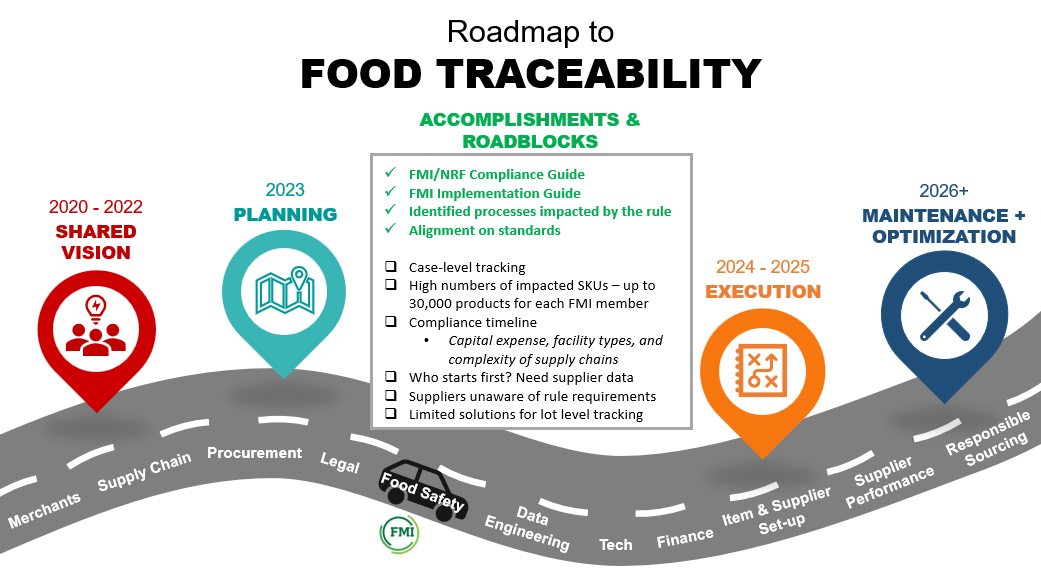By: Dana Mullen, Regulatory Counsel
 As nice as it would be for menu labeling regulations to be black and white, the details are as complex and colorful as a fully-stocked salad bar. The Food and Drug Administration (FDA) menu labeling requirements apply to standard menu items offered for sale in covered establishments comprised of 20 locations or more. Knowing if your grocery store is covered under the menu labeling regulations is the first step in the compliance process, but there are numerous other details affecting whether individual items must comply.
As nice as it would be for menu labeling regulations to be black and white, the details are as complex and colorful as a fully-stocked salad bar. The Food and Drug Administration (FDA) menu labeling requirements apply to standard menu items offered for sale in covered establishments comprised of 20 locations or more. Knowing if your grocery store is covered under the menu labeling regulations is the first step in the compliance process, but there are numerous other details affecting whether individual items must comply.
What is a Covered Establishment?
Four criteria must be met in order to be considered a covered establishment.
- Being part of a chain with 20 or more locations
- Doing business under the same name
- Selling substantially the same menu items
- Selling restaurant-type foods (foods eaten on the premises, while walking away, or soon after arriving at another location)
What foods are covered?
The menu labeling rules apply to standard menu items, which are defined a restaurant-type foods that are routinely included on a menu or menu board or routinely offered as a self-service food or food on display.
The menu labeling rules DO NOT apply to:
- Condiments for general use
- Daily specials
- Temporary menu items
- Custom orders
- Food that is part of a customary market test
- Alcoholic beverages that are foods on display and are not self-service foods
How are these rules enforced?
There are three general ways the rules can be enforced.
- FDA may enforce its own menu labeling rules.
- FDA may contract with states and localities to enforce FDA’s menu labeling rules.
- States may adopt identical menu labeling rules and enforce these identical menu labeling rules.
Possibility of fines:
- Section 303 of the Federal Food, Drug and Cosmetic Act (FFDCA) , which states that “any person who violates a provision of section 331 of this title shall be imprisoned for not more than one year or fined not more than $1,000 or both,” refers to criminal rather than civil penalties.
- In order for a company to be fined per this provision, there would need to be a formal criminal procedure, very unlikely in this context, as FDA does not often refer cases for criminal prosecution except under certain circumstances.
- States and localities could seek to impose penalties under their own legal frameworks if they have adopted and are enforcing their own (albeit identical) menu labeling rules.


 Industry Topics address your specific area of expertise with resources, reports, events and more.
Industry Topics address your specific area of expertise with resources, reports, events and more.
 Our Research covers consumer behavior and retail operation benchmarks so you can make informed business decisions.
Our Research covers consumer behavior and retail operation benchmarks so you can make informed business decisions.
 Events and Education including online and in-person help you advance your food retail career.
Events and Education including online and in-person help you advance your food retail career.
 Food Safety training, resources and guidance that help you create a company food safety culture.
Food Safety training, resources and guidance that help you create a company food safety culture.
 Government Affairs work — federal and state — on the latest food industry policy, regulatory and legislative issues.
Government Affairs work — federal and state — on the latest food industry policy, regulatory and legislative issues.
 Get Involved. From industry awards to newsletters and committees, these resources help you take advantage of your membership.
Get Involved. From industry awards to newsletters and committees, these resources help you take advantage of your membership.
 Best practices, guidance documents, infographics, signage and more for the food industry on the COVID-19 pandemic.
Best practices, guidance documents, infographics, signage and more for the food industry on the COVID-19 pandemic.
